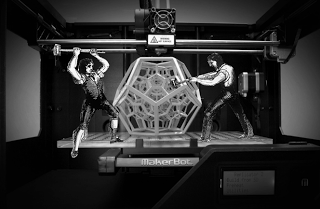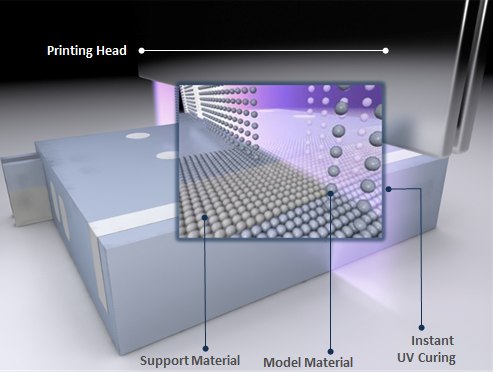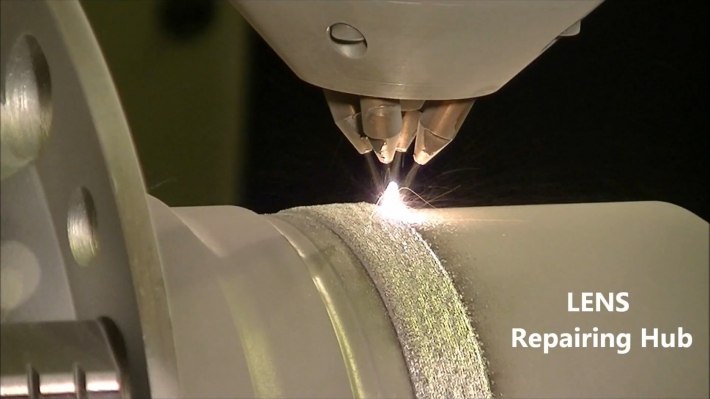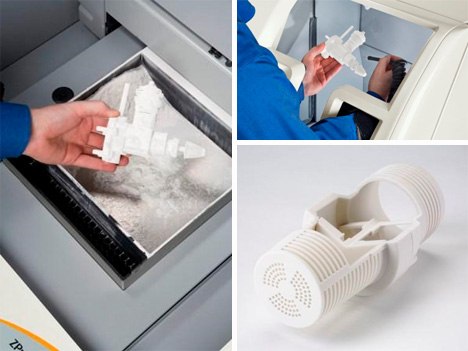Classification of 3D printers (7 3D printing technologies)
On Habré there were already articles about printing technologies that use 3D printers, but in this article I tried to approach the issue systematically, so that the reader had a clear picture of what principles are embedded in 3D printing technology, what materials are used and in the final as a result, which technology is better to use for obtaining a certain result, be it a titanium part, or a master model for subsequent replication.
Article based on the book Fabricated: The New World of 3D printing

')
1) FDM (fused deposition modeling) printers that squeeze out some material layer by layer through a metering nozzle, I will not paint in detail, we all know about them. All makerbot-like printers + Stratasys printers + various cooking printers (using glaze, cheese, dough) + medical ones that are printed with “live ink” (when a set of living cells is placed in a special medical gel that is used further in biomedicine)

2) Polyjet technology , was invented by the Israeli company Objet in 2000 in 2012 they were bought by Stratasys. The essence of the technology: photopolymer in small doses is fired from thin nozzles, as in inkjet printing, and immediately polymerizes on the surface of the manufactured device under the influence of UV radiation. An important feature that distinguishes PolyJet from stereolithography is the ability to print different materials.
The advantages of the technology: a) a layer thickness of up to 16 microns (a blood cell of 10 microns) b) prints quickly, since the liquid can be applied very quickly. Disadvantages of technology: a) prints only with the use of photopolymer - narrow-specialized, expensive plastic, usually UV-sensitive and quite fragile.
Application: industrial prototyping and medicine

3) LENS (LASER ENGINEERED NET SHAPING)
The powder-shaped material is blown out of the nozzle and hits the focused laser beam. Part of the powder flies past, and the part that gets into the focus of the laser instantly sinter and layer after layer forms a three-dimensional part. This technology is used to print steel and titanium objects.
Since before the advent of this technology, it was possible to print only plastic objects, no one took the 3D printing particularly seriously, and this technology opened the doors for 3D printing in the “big” industry. Powders of various materials can be mixed and thus alloys are prepared, on the fly.
Application: for example, titanium blades for turbines with internal cooling channels. Equipment manufacturer: Optomec

4) LOM (laminated object manufacturing)
Thin laminated sheets of material are cut out with a knife or laser and then sintered or glued into a three-dimensional object. Those. a thin sheet of material is laid out, which is cut along the contour of the object, thus one layer is obtained, the next sheet is placed on it, and so on. After that, all sheets are pressed or sintered.
In this way, 3D models are made of paper, plastic or aluminum. For printing models of aluminum, thin aluminum foil is used, which is cut along the contour layer by layer and then sintered using ultrasonic vibration.

1) SL (Stereolithography) Stereolithography.
There is a small bath with a liquid polymer. The laser beam passes over the surface, and in this place the polymer polymerizes under the influence of UV. After one layer is ready the platform with the part goes down, the liquid polymer fills the void, the next layer is baked, and so on. Sometimes it happens the other way around: the platform with the part rises up, the laser is respectively located below ...
After printing using this method, a post-processing of the object is required - removal of excess material and support, sometimes the surface is polished. Depending on the required properties of the target object, the model is baked in the so-called. ultraviolet ovens.
Photopolymer is often toxic so when working with it you need to use protective equipment and respirators. Maintaining and maintaining such a printer at home is difficult and expensive.
Advantages: fast and accurate, accuracy up to 10 microns. For sintering a photopolymer, a laser from a Blu-ray player is sufficient, due to which cheap precision printers using this technology appear on the market (eg Form1).

2) LS (laser sintering)
Laser sintering. It looks like SL, but instead of liquid photopolymer powder is used that is sintered with a laser.
Advantages: a) it is less likely that the part will break during the printing process, since the powder itself acts as a reliable support; b) materials in powder form are fairly easy to find on the market, including bronze, steel, nylon, titanium
Disadvantages: a) the surface turns porous b) some powders are explosive, therefore they must be stored in chambers filled with nitrogen c) sintering occurs at high temperatures, so the finished parts cool for a long time, depending on the size and thickness of the layers, some objects can cool down to one day .

3) 3DP (three dimensional printing)
The technology was invented in 1980 at MIT by student Paul Williams, the technology was sold to several commercial organizations, one of which is zCorp, currently absorbed by 3D Systems.
An adhesive is applied to the material in powder form, which binds the granules, then a fresh layer of powder is applied on the glued layer, and so on. At the exit, as a rule, the material is obtained sandstone (similar in properties to gypsum)
Advantages: a) since glue is used, paint can be added to it and thus colored objects can be printed b) technology is relatively cheap and energy efficient c) can be used in a home or office environment c) glass powder, bone powder, recycled rubber can be printed bronze and even sawdust. Using similar technology, you can print edible objects such as sugar or chocolate powder. The powder is glued with a special food glue; a dye and flavoring agent can be added to the glue. As an example, new 3D printers from 3D systems, which were demonstrated at CES 2014 - ChefJet and ChefJet Pro
Disadvantages: a) the output is a fairly rough surface, with a low resolution of ~ 100 microns b) the material must be subjected to post-processing (baked) in order to give it the necessary properties.

I hope the material will be useful for you.
Additions are accepted.
Article based on the book Fabricated: The New World of 3D printing

I. Those who squeeze something or pour or spray
')
1) FDM (fused deposition modeling) printers that squeeze out some material layer by layer through a metering nozzle, I will not paint in detail, we all know about them. All makerbot-like printers + Stratasys printers + various cooking printers (using glaze, cheese, dough) + medical ones that are printed with “live ink” (when a set of living cells is placed in a special medical gel that is used further in biomedicine)

2) Polyjet technology , was invented by the Israeli company Objet in 2000 in 2012 they were bought by Stratasys. The essence of the technology: photopolymer in small doses is fired from thin nozzles, as in inkjet printing, and immediately polymerizes on the surface of the manufactured device under the influence of UV radiation. An important feature that distinguishes PolyJet from stereolithography is the ability to print different materials.
The advantages of the technology: a) a layer thickness of up to 16 microns (a blood cell of 10 microns) b) prints quickly, since the liquid can be applied very quickly. Disadvantages of technology: a) prints only with the use of photopolymer - narrow-specialized, expensive plastic, usually UV-sensitive and quite fragile.
Application: industrial prototyping and medicine

3) LENS (LASER ENGINEERED NET SHAPING)
The powder-shaped material is blown out of the nozzle and hits the focused laser beam. Part of the powder flies past, and the part that gets into the focus of the laser instantly sinter and layer after layer forms a three-dimensional part. This technology is used to print steel and titanium objects.
Since before the advent of this technology, it was possible to print only plastic objects, no one took the 3D printing particularly seriously, and this technology opened the doors for 3D printing in the “big” industry. Powders of various materials can be mixed and thus alloys are prepared, on the fly.
Application: for example, titanium blades for turbines with internal cooling channels. Equipment manufacturer: Optomec

4) LOM (laminated object manufacturing)
Thin laminated sheets of material are cut out with a knife or laser and then sintered or glued into a three-dimensional object. Those. a thin sheet of material is laid out, which is cut along the contour of the object, thus one layer is obtained, the next sheet is placed on it, and so on. After that, all sheets are pressed or sintered.
In this way, 3D models are made of paper, plastic or aluminum. For printing models of aluminum, thin aluminum foil is used, which is cut along the contour layer by layer and then sintered using ultrasonic vibration.

Ii. Those that sinter something or glue
1) SL (Stereolithography) Stereolithography.
There is a small bath with a liquid polymer. The laser beam passes over the surface, and in this place the polymer polymerizes under the influence of UV. After one layer is ready the platform with the part goes down, the liquid polymer fills the void, the next layer is baked, and so on. Sometimes it happens the other way around: the platform with the part rises up, the laser is respectively located below ...
After printing using this method, a post-processing of the object is required - removal of excess material and support, sometimes the surface is polished. Depending on the required properties of the target object, the model is baked in the so-called. ultraviolet ovens.
Photopolymer is often toxic so when working with it you need to use protective equipment and respirators. Maintaining and maintaining such a printer at home is difficult and expensive.
Advantages: fast and accurate, accuracy up to 10 microns. For sintering a photopolymer, a laser from a Blu-ray player is sufficient, due to which cheap precision printers using this technology appear on the market (eg Form1).

2) LS (laser sintering)
Laser sintering. It looks like SL, but instead of liquid photopolymer powder is used that is sintered with a laser.
Advantages: a) it is less likely that the part will break during the printing process, since the powder itself acts as a reliable support; b) materials in powder form are fairly easy to find on the market, including bronze, steel, nylon, titanium
Disadvantages: a) the surface turns porous b) some powders are explosive, therefore they must be stored in chambers filled with nitrogen c) sintering occurs at high temperatures, so the finished parts cool for a long time, depending on the size and thickness of the layers, some objects can cool down to one day .

3) 3DP (three dimensional printing)
The technology was invented in 1980 at MIT by student Paul Williams, the technology was sold to several commercial organizations, one of which is zCorp, currently absorbed by 3D Systems.
An adhesive is applied to the material in powder form, which binds the granules, then a fresh layer of powder is applied on the glued layer, and so on. At the exit, as a rule, the material is obtained sandstone (similar in properties to gypsum)
Advantages: a) since glue is used, paint can be added to it and thus colored objects can be printed b) technology is relatively cheap and energy efficient c) can be used in a home or office environment c) glass powder, bone powder, recycled rubber can be printed bronze and even sawdust. Using similar technology, you can print edible objects such as sugar or chocolate powder. The powder is glued with a special food glue; a dye and flavoring agent can be added to the glue. As an example, new 3D printers from 3D systems, which were demonstrated at CES 2014 - ChefJet and ChefJet Pro
Disadvantages: a) the output is a fairly rough surface, with a low resolution of ~ 100 microns b) the material must be subjected to post-processing (baked) in order to give it the necessary properties.

I hope the material will be useful for you.
Additions are accepted.
Source: https://habr.com/ru/post/208906/
All Articles